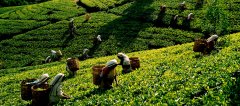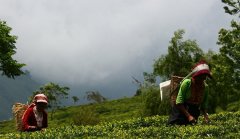India's oldest Darjeeling black tea estate brand Alobari Darjeeling
Darjeeling was originally conceived as a sanatorium, and the British came to Darjeeling with the aim of establishing a sanatorium for their soldiers. Dr. Campbell was the first inspector of Darjeeling, and it was he who actually promoted the growth of tea (albeit on an experimental basis) in the Darjeeling mountains in 1841. It is said that he managed to obtain seeds of some chinese varieties and planted them around his bungalow, now known as beechwood, and dr campbell's experiments bore fruit. Tea trees grow very large-some grow to 20 feet tall. It was soon discovered that Darjeeling's climate was very suitable for tea production. The government offered land on favorable terms, and many entrepreneurs stepped forward to seize the opportunity. The government then devised a formula according to which each distributor of forest land could set aside only 40 per cent of the land for tea, the rest remaining pure forest. In 1856, under the management of the Turtle City and Darjeeling Tea Company, Captain Samler opened the Arubali Tea Garden and was the first tea farmer. And then there's Hassim Gardens. Dooteriah was born in 1859. Darjeeling Tea Company introduced Jing, Ambutia, Takdah and Phoobsering between 1860 and 1864. Le Bang Tea Company also founded Tukwa and Badam tea plantations during this period. Pandam, Stenthal, Makaibari and Singell tea plantations also appeared at that time. By the end of 1874, there were 113 tea plantations covering 18888 acres and employing 19000 workers. By 1905, Darjeeling had 117 tea plantations covering 427,000 acres. At present, there are 69 plantations in the park, covering an area of more than 50,000 mu, with 50,000 fixed employees and 30,000 temporary employees in picking season. They also provide livelihoods for a large number of people engaged in transportation, supply, repair and maintenance of hardware and sales. India has two different kinds of tea. Camellia Sinensis can grow up to 20 feet tall and Camellia Assamica can grow up to 30 feet tall like any other tree. The proportion of tea planted today is different. About 25 percent of plantations have been converted to "organic," meaning they have stopped using fertilizers and pesticides altogether. Use only natural fertilizers and plant pesticides. The Swiss Institute for Marketecology has certified organic plantations after extensive laboratory testing of the soil and the tea produced.

Darjeeling is a town and municipality in West Bengal, India. Located in the Little Himalayas, it is famous for its tea industry, magnificent views of Mount Kangcheng Zhangjia, the third highest mountain in the world, and the Darjeeling Himalayan Railway. Tea cultivation in Darjeeling began in 1841, using Chinese tea seeds; the British government also established tea plantations, during which time the Alubali Tea Plantation was opened by the Nine Cities and Darjeeling Tea Company in 1856, and soon there were more than 80 tea plantations. At a majestic height of 6562 feet, the garden is caressed by cool breezes from the snow-capped Himalayas, which give Aloobari tea its distinctive flavor. The first tea trees continued to flourish in the mountainous northeast of Darjeeling, providing tea lovers with a history of delicate floral aromas.
Important Notice :
前街咖啡 FrontStreet Coffee has moved to new addredd:
FrontStreet Coffee Address: 315,Donghua East Road,GuangZhou
Tel:020 38364473
- Prev

General situation of Seven Black Tea producing areas in Sri Lanka the characteristics of black tea and the story of tea garden in Siran Wuwa Highland in Daquan
As early as 1824, the British brought a kind of tea tree from China to Ceylon (then Sri Lanka). It is planted in the Royal Botanical Garden Peradeniya and is considered to be the first non-commercial tea tree in Sri Lanka. In 1867, the Scottish James Taylor (JamesTaylo)
- Next

Which tea garden in Darjeeling produces good black tea? Characteristics of ambootia Anbutia's best spring-picked tea
The Ambootia Anbutia Tea Garden is located in the undulating mountains of Darjeeling in the North Nine City. the cool mountain breeze and Himalayan springs energize the tea trees. Since 1861, Ambootia has practiced the art of fine tea in this healthy environment. Ambootia Ambuti
Related
- Being chased out of the rain in front of Starbucks?! Store: Sheltering from rain under umbrellas poses a safety hazard
- The white moonlight has changed?! Lucky launches "Big Winter Pear American"
- Hand-brewed coffee three-stage method, high-sweet and universal brewing method to share! What does the high sweet water level of hand-brewed coffee mean?
- What is the difference between raw, refined and full espresso coffee? How to extract espresso and taste good?
- A complete list of coffee bean names and their meanings! What is Yejia Shefi coffee? Where is Mantelin coffee?
- What grade does Arida Manor Kaduai coffee beans belong to? What treatment is Arida ASD slow anaerobic sun exposure?
- The milk tea cup becomes smaller?! Overlord Tea Girl launches a new "Return to Yunnan" series
- Accused of selling counterfeit and high-priced coffee beans! Well-known boutique coffee brand "Oukelao" bowed and apologized!
- How to make espresso dumplings? Can I eat coffee and glutinous rice balls together?
- Save the unformed and stagnant powder cakes in one second! What is the problem with stagnant water in the powder bowl of the espresso machine?

